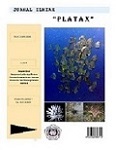Secondary Metaboliti of Gorgonia, Paramuricea clavata
DOI:
https://doi.org/10.35800/jip.5.1.2017.14971Abstract
Gorgonians are important organisms living around coral reefs. They have high abundance and very important ecological role. They can be found in shalow to deep sea. Gorgonians belong to octoral taxon rarely studied either their taxonomy or other aspects. Some studies have informed that gorgonians can produce secondary metabolites as anti-bacteria. These belong to terpenoid, alkaloid, and steroid groups. The objective of this study was to obtain secondary metabolites of gorgonian, Paramuricea clavata, through several analytical steps, i.e. extraction, partition, chromatograpgy, and spectroscopy. Extraction was done through 5 phases of maceration and then continued with partition, chromatography, and spectroscopy.
The secondary metabolites detected in ethyl acetate solvent, such as flavonoid, triterpenoid, steroid, and saponin, were the same as those in n-hexane solvent, while not all these compounds were detected in methanol solvent.Steroid was found in all gorgonian samples extracted in all solvent materials used in this study. Triterpenoid was also detected in gorgonian skin and axial extract using ethyl acetate, n-hexane, and methanol. Saponin was detected in all gorgonian extract, except the axial extract using ethyl acetate solvent.
Keywords: Secondary metabolite, Gorgonia, anti-bacteria.
Â
Abstrak
Gorgonia merupakan organisme penting yang hidup di sekitar terumbu karang. Hewan ini memiliki kelimpahan besar dan peranan ekologis yang sangat ppenting. Organisme ini dapat ditemukan di perairan dangkal sampai laut dalam. Gorgonia termasuk taksa octokoralia yang jarang diteliti baik taksonominya maupun aspek-aspek lain. Beberapa penelitian telah menginformasikan bahwa gorgonia dapat menghasilkan metablit sekunder sebagai anti-baketri. Senyawa-senyawa ini termask golongan terpenoid, alkaloid dan steroid. Tujuan penelitian ini adalah untuk mendapatkan metabolit sekunder gorgonia (Paramuricea clavata) melalui beberapa tahap analisis, yaitu ekstraksi, partisi, kromatografi, dan spektroskopi. Ekstraksi dilakukan melalui 5 tahap maserasi dan dilanjutkan dengan partisi, kromatografi, dan spectroskopy.
Metabolit sekunder yang terdeteksi pada larutan ethil asetat, seperti flavonoid, triterpenoid, steroid dan saponin adalah sama dengan pada pelarut n-heksan, sedangkan tidak semua senyawa ini terdeteksi pada pelarut metanol. Steroid ditemukan pada semua sampel gorgonia yang diekstrak dalam semua bahan pelarut yang digunakan pada penelitian ini. Triterpenoid terdeteksi pada ekstrak kulit dan aksial gorgonia yang menggunakan pelarut ethil asetat, n-hexane, dan methanol. Saponin terdeteksi pada semua ekstrak gorgonia, kecuali ekstrak axial yang menggunakan pelarut ethil asetat.
Downloads
Published
How to Cite
Issue
Section
License
COPYRIGHT
Authors who publish with this journal agree to the following terms:
Authors hold their copyright and grant this journal the privilege of first publication, with the work simultaneously licensed under a Creative Commons Attribution License that permits others to impart the work with an acknowledgment of the work's origin and initial publication by this journal.
Authors can enter into separate or additional contractual arrangements for the non-exclusive distribution of the journal's published version of the work (for example, post it to an institutional repository or publish it in a book), with an acknowledgment of its underlying publication in this journal.
Authors are permitted and encouraged to post their work online (for example, in institutional repositories or on their website) as it can lead to productive exchanges, as well as earlier and greater citation of the published work (See The Effect of Open Access).




















